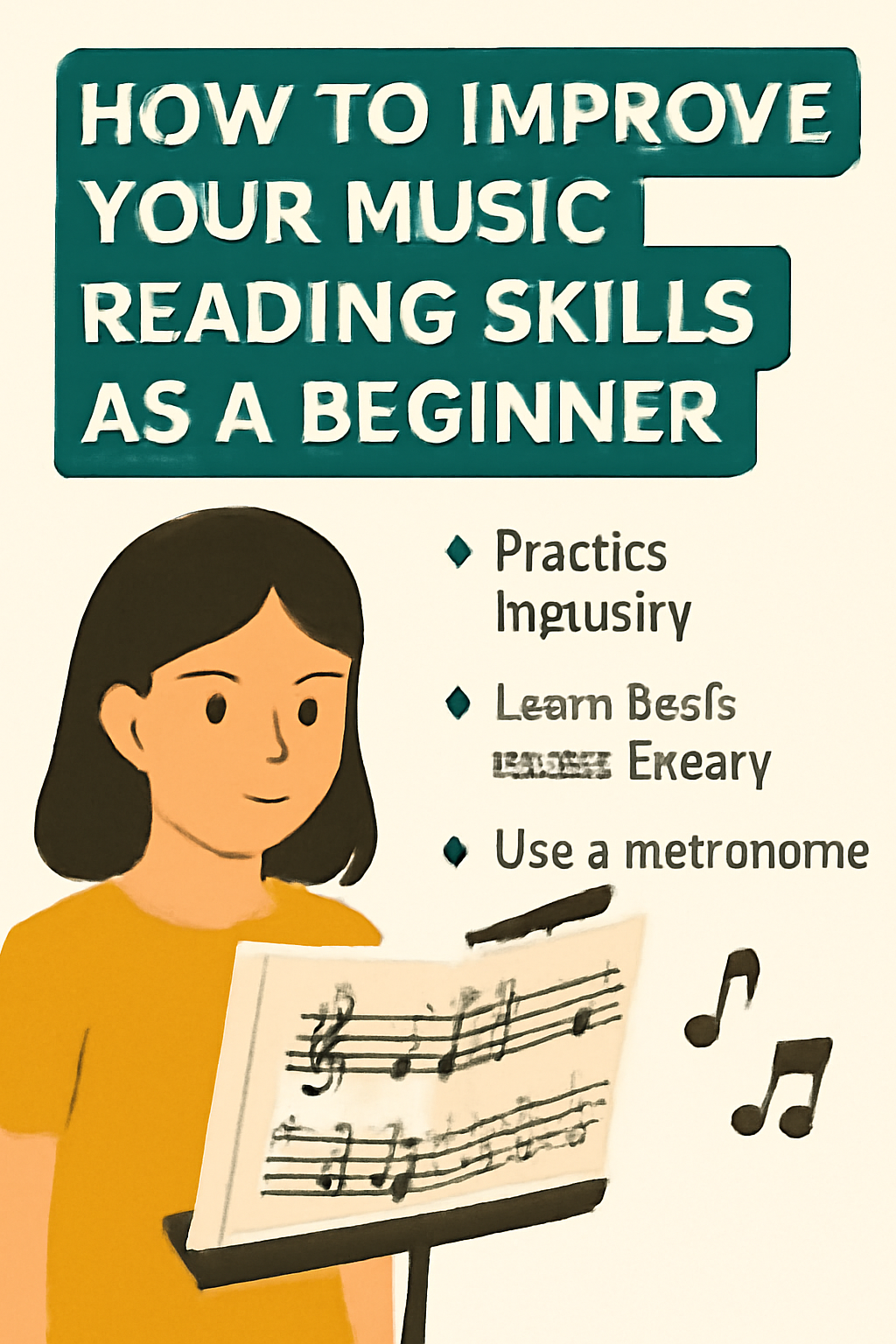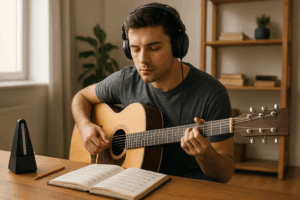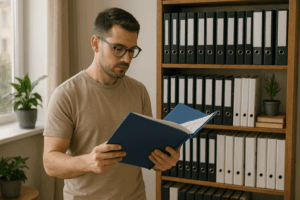Music reading, or sight-reading, is one of the most essential skills a musician can develop. Whether you’re learning to play piano, guitar, violin, or any other instrument, the ability to read music will allow you to access a vast library of music and expand your understanding of musical concepts.
For beginners, music reading may seem intimidating, especially when confronted with complex notes, rhythms, and symbols. However, like any skill, it can be developed with patience and consistent practice. In this article, we will explore how you can improve your music reading skills from the very start of your musical journey.
Why Music Reading is Crucial for Beginners
Music reading allows you to play music directly from notation without having to rely on memory or a tutor. Here’s why it’s so important:
- Expand Your Repertoire: The ability to read music opens up a world of possibilities, allowing you to learn songs more easily and quickly.
- Improves Musical Understanding: Reading music helps you better understand musical structure, theory, and the relationship between rhythm, melody, and harmony.
- Play Independently: Once you can read music, you can practice and perform new pieces on your own, without needing to rely on others to teach you.
- Faster Learning: Instead of struggling to memorize each song by ear, reading music allows you to pick up pieces more efficiently and practice new songs at your own pace.
For beginners, learning to read music may feel overwhelming, but with the right approach, you can start developing your music reading skills right from the beginning.
1. Learn the Basics of Music Notation
Before diving into music reading exercises, it’s essential to understand the basics of music notation. Familiarize yourself with the essential symbols used in music, such as:
- Staff: The five horizontal lines on which notes are written.
- Clefs: Symbols that indicate the pitch of the notes. The treble and bass clefs are the most commonly used.
- Notes: The symbols that represent sound in music. They are placed on the staff and indicate pitch and duration.
- Rests: Symbols that indicate silence in music and are used to represent specific durations of silence.
- Time Signature: A symbol that indicates how many beats are in each measure and which note value gets one beat.
- Key Signature: A set of sharps or flats that indicate the key of the piece of music.
How to Get Started:
- Familiarize Yourself with the Notes: Learn the names of the notes on the lines and spaces of the staff for both treble and bass clefs.
- Understand Rhythms: Learn the different note values such as whole notes, half notes, quarter notes, and eighth notes, as well as corresponding rests.
- Memorize Basic Symbols: Start by memorizing the basic symbols, such as clefs, notes, and time signatures.
Once you have a basic understanding of these elements, you can start reading simple sheet music.
2. Start with Simple Pieces of Music
As a beginner, it’s essential to start with simple pieces of music that are easy to read and understand. These pieces will help you gradually build your music reading skills without overwhelming you.
How to Practice:
- Start with Easy Songs: Look for beginner-level sheet music, such as simple folk songs, nursery rhymes, or well-known children’s songs.
- Slow Tempo: Play the music at a slow tempo and focus on reading each note accurately. You can use a metronome to maintain a consistent tempo.
- Focus on One Hand at a Time: If you’re playing an instrument like piano, start by reading and practicing one hand at a time. Once you feel comfortable, combine both hands.
These small, manageable pieces will help you develop your confidence and accuracy when reading music.
3. Practice Sight-Reading Regularly
Sight-reading is the ability to read and play music on the spot, without prior practice or preparation. It’s an essential skill for musicians, but it requires practice to develop. Start with easy pieces and work your way up to more complex pieces over time.
How to Improve Sight-Reading:
- Practice Daily: Set aside time every day to practice sight-reading. Even 10-15 minutes of focused practice will help you make steady progress.
- Use Sight-Reading Exercises: Many books and apps offer sight-reading exercises for beginners. These exercises will help you improve your ability to read music quickly and accurately.
- Don’t Stop for Mistakes: If you make a mistake while sight-reading, keep going. The goal is to keep the flow of the music going, not to stop and correct every error.
By practicing sight-reading regularly, you’ll become more comfortable with reading music on the fly.
4. Focus on Rhythms and Timing
Understanding rhythms and timing is crucial for music reading. Being able to read and understand the rhythms of a piece of music will help you play it accurately. As a beginner, it’s essential to start by focusing on simple rhythms and gradually progressing to more complex patterns.
How to Practice Rhythms:
- Clap the Rhythms: Before playing a piece of music, clap the rhythms of the notes. This will help you internalize the timing and rhythm of the music before adding the notes.
- Use a Metronome: A metronome helps you stay in time and practice rhythm accurately. Start slow and gradually increase the tempo as you become more comfortable.
- Practice with Different Time Signatures: Start with pieces in 4/4 time and then progress to other time signatures such as 3/4 or 6/8.
Practicing rhythm regularly will help you play music with proper timing and accuracy.
5. Learn to Read and Play Simultaneously
One of the most challenging aspects of music reading is being able to read the music while playing it at the same time. This requires coordination between your eyes, fingers, and brain, and it takes time to develop.
How to Practice Reading and Playing Together:
- Start Slow: Don’t try to play at full speed right away. Start slow and focus on reading the notes while keeping your hands in the correct positions.
- Use Simple Pieces: Begin with easy songs and practice reading the notes while playing the correct rhythms. As you improve, gradually move on to more complex pieces.
- Break It Down: Practice reading small sections of the music, such as one measure or a few bars, and gradually work up to playing the entire piece.
This process will help you develop the ability to read and play music simultaneously.
6. Consistent Practice and Patience
Reading music is a skill that takes time to develop, and it requires consistent practice. Don’t get discouraged if progress feels slow at first. The more you practice, the more fluent you’ll become in reading music.
Tips for Consistent Practice:
- Set Goals: Set small, achievable goals for each practice session. For example, aim to read a specific piece of music or work on a particular rhythm pattern.
- Be Patient: Remember that progress takes time. Celebrate small milestones along the way, and stay patient with yourself as you develop your skills.
With regular practice and dedication, your music reading skills will improve over time.
Learning to read music is a fundamental skill that every musician should develop, and it’s something that can be mastered with consistent practice and patience. Start by learning the basics of music notation, and gradually work your way up to more complex pieces. With the right approach and steady practice, you’ll be able to read and play music with confidence.
Keep practicing, stay motivated, and enjoy the process of learning to read music. The more you read, the more fluent you’ll become, and the more music you’ll be able to explore and enjoy.




